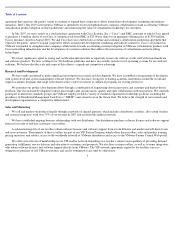VMware 2007 Annual Report Download - page 21
Download and view the complete annual report
Please find page 21 of the 2007 VMware annual report below. You can navigate through the pages in the report by either clicking on the pages listed below, or by using the keyword search tool below to find specific information within the annual report.
Table of Contents
software and/or that we license such modifications or derivative works under the terms of the particular open source license.
If an author or other third party that distributes such open source software were to allege that we had not complied with the conditions of
one or more of these licenses, we could be required to incur significant legal expenses defending against such allegations. If our defenses were
not successful, we could be subject to significant damages, enjoined from the distribution of our products that contained the open source
software and required to comply with the foregoing conditions, which could disrupt the distribution and sale of some of our products. In
addition, if we combine our proprietary software with open source software in a certain manner, under some open source licenses we could be
required to release the source code of our proprietary software, which could substantially help our competitors develop products that are similar
to or better than ours.
In addition to risks related to license requirements, usage of open source software can lead to greater risks than use of third party
commercial software, as open source licensors generally do not provide warranties or assurance of title or controls on origin of the software. We
have established processes to help alleviate these risks, including a review process for screening requests from our development organizations
for the use of open source, but we cannot be sure that all open source is submitted for approval prior to use in our products. In addition, many of
the risks associated with usage of open source, such as the lack of warranties or assurances of title, cannot be eliminated, and could, if not
properly addressed, negatively affect our business.
Our sales cycles can be long and unpredictable, and our sales efforts require considerable time and expense. As a result, our sales are
difficult to predict and may vary substantially from quarter to quarter, which may cause our operating results to fluctuate significantly.
The timing of our revenue is difficult to predict. Our sales efforts involve educating our customers about the use and benefit of our
products, including their technical capabilities, potential cost savings to an organization and advantages compared to lower-
cost products offered
by our competitors. Customers typically undertake a significant evaluation process that has in the past resulted in a lengthy sales cycle, which
typically lasts several months, and may last a year or longer. We spend substantial time, effort and money on our sales efforts without any
assurance that our efforts will produce any sales. In addition, product purchases are frequently subject to budget constraints, multiple approvals,
and unplanned administrative, processing and other delays. Additionally, the greater number of competitive alternatives, as well as
announcements by our competitors that they intend to introduce competitive alternatives at some point in the future, can lengthen customer
procurement cycles, cause us to spend additional time and resources to educate end users on the advantages of our product offerings and delay
product sales. If sales expected from a specific customer for a particular quarter are not realized in that quarter or at all, our results could fall
short of public expectations and our business, operating results and financial condition could be materially adversely affected.
Our current research and development efforts may not produce significant revenues for several years, if at all.
Developing our products is expensive. Our investment in research and development may not result in marketable products or may result in
products that take longer to generate revenues, or generate less revenues, than we anticipate. Our research and development expenses were
$285.9 million, or 22% of our total revenues in 2007, and $148.3 million, or 21% of our total revenues in 2006. Our future plans include
significant investments in software research and development and related product opportunities. We believe that we must continue to dedicate a
significant amount of resources to our research and development efforts to maintain our competitive position. However, we may not receive
significant revenues from these investments for several years, if at all.
We may not be able to respond to rapid technological changes with new solutions and services offerings, which could have a material
adverse effect on our sales and profitability.
The markets for our software solutions are characterized by rapid technological changes, changing customer needs, frequent new software
product introductions and evolving industry standards. The introduction of third-
17
























